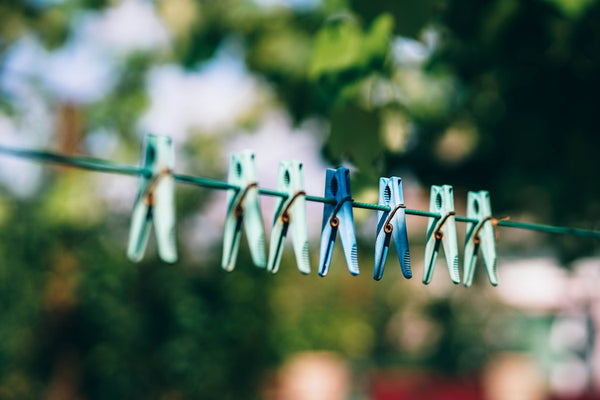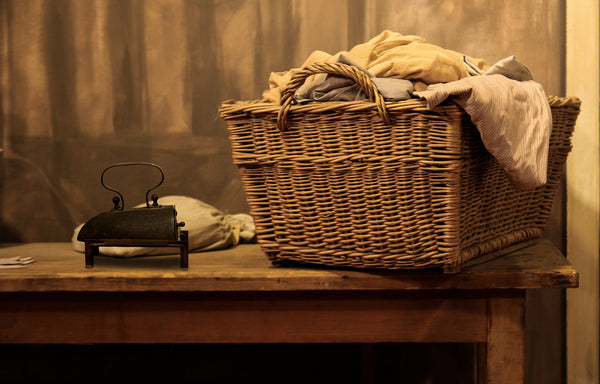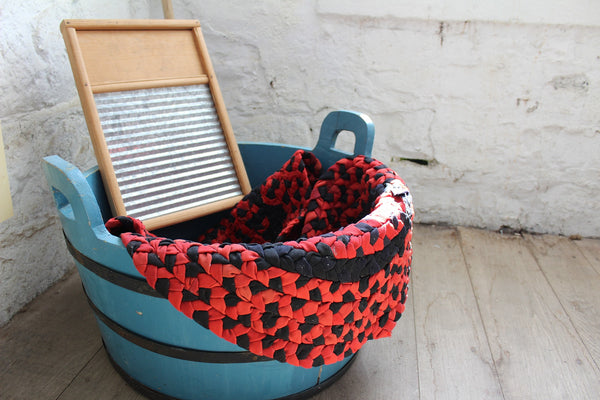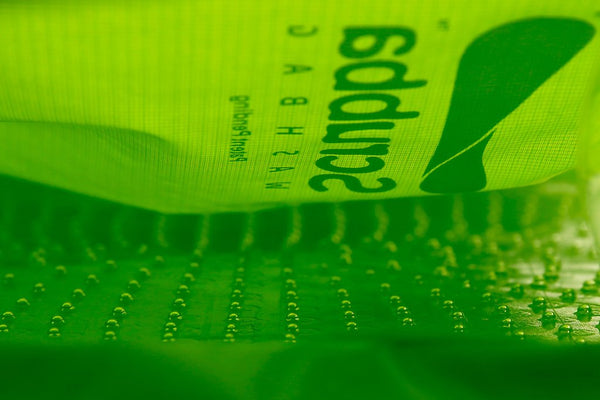Old Fashioned Way to Do Laundry

Washing is as like shooting fish in a barrel as throwing your dirty clothes on the flooring, gathering them upward a few days later, tossing them into the machine, and pressing a few buttons, right? While that may be the standard of washing in many locations today, I'm sure you're aware that this hasn't always been – and still isn't in many places – the reality. Indeed, early civilisations oft found themselves laboriously washing clothes down by the local river, a tiring yet effective method all the same practised in many areas today, where one can discover extensive washing taking place at popular locations including the banks of the Ganges and Lake Victoria. Yet while this aboriginal laundry method is nevertheless widely practised and unlikely to fall out of favour someday soon, at that place's no doubtfulness that many other washing methods, nourished by varying degrees of popularity and effectiveness, have emerged throughout the ages – our very ainScrubba launder pursebeing a prime example!
Nosotros've decided to wring out all the facts on this surprisingly interesting topic, and so to learn how people used to wash and how your very own ancestors may have in one case scrubbed away at their favourite outfits, check out the timeline beneath.

Washing in the aboriginal world. Water is the source of life:
It's no undercover why near Ancient Civilisations developed around at least one source of water. Vital for a number of aspects of everyday life, including hydration, nutrient supply, transportation, and crop irrigation, water systems were of course also used extensively for cleaning both people and the clothes they wore. Garments were typically beaten over rocks, scrubbed with abrasive sand or stone, and pounded underfoot or with wooden implements. Poorer members of the community probable had little multifariousness when information technology came to article of clothing selection, and many garments may accept remained largely unwashed equally they were passed down through the generations.
As with many other pursuits, the Romans took this basic concept of washing and catapulted it into a commercial manufacture of unprecedented calibration. Post-obit the shift from homespun fabrics to more than cheaply produced garments that allowed for larger wardrobes and more than frequent toga changes, efficient laundry became a necessity. The demand was even further bolstered by the importance the Romans placed upon hygiene and physical appearance, and eventually the Roman fullers (cleaners who dyed, washed and dried clothes of all varieties) became indispensable to Roman life.
Earlier you celebrate the Roman'due south ingenuity and liken their fuller shops to mod mean solar day laundromats, however, you should probably know that they washed the wearing apparel they received in man urine nerveless from public restrooms. Although revolting by modern hygiene standards, urine, containing ammonia, was an of import cleaning agent non merely in Roman times, but also in Medieval Europe, when it was referred to every bit chamber-lye and usually used as a stain-remover to dissolve grease, loosen dirt, and bleach yellowing fabrics. If yous're however convinced there must have been something preferable to human urine, you may be surprised to learn that lather, itself boasting an interesting and tumultuous history, wouldn't get widely available until the xixth-century, leaving piffling selection for the maids and cleaners of the mean solar day.

Washing in the Center Ages. Washing away from the river:
As culture adult, population grew, and cities became booming urban centres, a river bed and a pile of rocks were no longer sufficient for many people. Several items designed to help with the washing process therefore become commonplace, including big wooden washtubs and dolly-tubs or possing-tubs – tall tubs in which clothes were browbeaten and stirred with a plunger. Washing in this flow could be incredibly physically demanding and was ofttimes undertaken past poor servants and washerwomen on an irregular basis in a gruelling process known as the "dandy wash". Indeed, the length and intensity of the washing process (the entire thing oft took a few days involving a pre-wash, a 24 hour soaking period, a wash that took nearly 15 hours on account of the need to continually reheat the lye, a further launder of the lye-soaked linen, and finally a rinsing and drying process), coupled with the fact that people took pride in owning enough linen to avert the demand for frequent washes, made it preferable for households to wash everything at the same time every few weeks. It certainly tin can't have been an outcome that the washers of the time looked forwards to!

Washing during the Industrial Revolution. The Rise of the Washboard:
The advent of the Industrial Revolution is when washing finally starts to accrue some more recognisable characteristics. Indeed, the popular washboard, typically attributed to the Scandinavians, was greatly refined in nineteenth-century America following technological advances that saw the primitive rigid wooden frame improved with materials including fluted metal sheets and safety. The washboard was small, portable, and effective, quickly propelling information technology to the condition of household necessity. Its ease of use, coupled with the increasing accessibility and affordability of soap - fuelled by society'south growing awareness of wellness and hygiene - besides helped to cement the notion of regular washing cycles. This is evidenced by the popularity of the Monday launder 24-hour interval throughout the Victorian menstruation, the logic beingness that clothes washed on Monday had plenty of time to be dried, pressed, aired and folded before Sunday.
The popularity of the apprehensive washboard speaks for itself, simply did yous know that its staggering reputation was a jumbo influence on our own Scrubba wash pocketbook? Indeed, managing director, Ash Newland, was eager to bring the tool'southward effectiveness into the 21st-century to help travellers and outdoor enthusiasts wash around the globe, and it is forth the principles of the old-fashioned washboard that he designed the Scrubba wash purse's internal, flexible washing mechanism.

Doing Laundry in the Present Day. More Advanced Technology:
As technological, scientific, and chemic advances continued to dominate the Victorian era, old methods of washing, at least throughout the English-speaking world and parts of Europe, were almost completely supplanted past revolutionary implements, soaps, and washing powders. This led to the beginning electric-powered washing automobile in 1908 and the showtime automatic washing machines in 1951. Today, the washing automobile remains a mainstay of many modern homes, forth with countless other laundry tools designed to simplify and better the quality of washing, including electronic driers, irons, and diverse clotheslines and other hanging devices.
Equally technology continues to improve within the home, it besides begins to evolve with the rapid globalisation of today's fast-paced world. This has lead to multiple methods for effectively doing laundry while travelling, including our very own Scrubba launder bag. Equipped with a flexible, internal washboard designed to deliver a machine-quality wash in only three minutes, it promises to bring the laundry right into your home away from abode - wherever that may be!

The Scrubba wash bag's flexible, internal washboard
From riverside washing and apprehensive washboards to advanced washing machine technology and our very own Scrubba wash pocketbook, little has remained constant throughout the turbulent history of laundry besides the certainty that washing methods will go on to alter and ameliorate in accord with global needs, every bit will our very ownScrubba product range.
Learn more about how the Scrubba wash handbag is fabricated.
Further Reading:
http://www.hygieneforhealth.org.au/hh_laundry.php
http://world wide web.oldandinteresting.com/default.aspx
https://world wide web.aboriginal.eu/article/46/the-fullers-of-rome/
https://www.thoughtco.com/history-of-washing-machines-1992666
0 Response to "Old Fashioned Way to Do Laundry"
Post a Comment